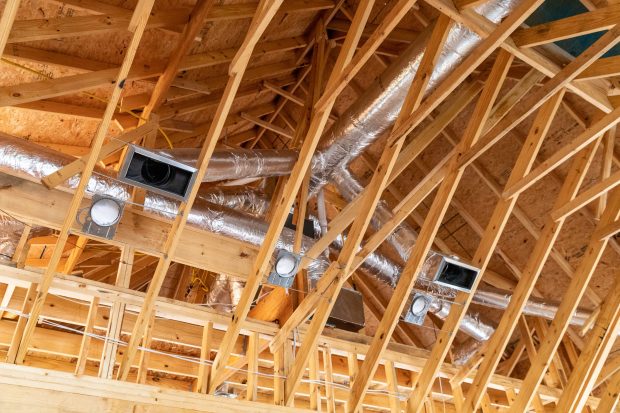Home ductwork serves to move air between heating, ventilation, and air-conditioning equipment and the house itself. When properly installed and maintained, this system provides efficient, comfortable, well-distributed air flow throughout your living space.
Furnaces connect to the main trunk line through a plenum, while branch lines branch off with take-offs, reducers, cleats, and angled boots ending in wall registers or stack heads. You should also read this does home warranty cover ductwork article for some extra things you need to know.

Sheet Metal
Many HVAC contractors have abandoned metal ductwork in new houses in favor of flexible ducts made from metal wire coils covered with polyethylene film, known as flex ducting. It is most often seen in ranch-style homes that include bedrooms above corridors held together with S cleats or drives for access. Flex duct cleaning requires more sensitive cleaning strategies and cleaners to effectively get all lining removed from within its pipes.
Fabricating the ducts takes place in a sheet metal shop. The fabrication process involves mechanically deforming forces which alter their shape; optimizing this aspect of fabrication helps minimize attic downtime during installation projects.
Dependent upon the desired end product, various materials are utilized in manufacturing processes. Steel is commonly used for making ducts due to its strength and durability; galvanized mild steel offers another strong option that resists corrosion well.
Fiberboard
Ducts made of fiberglass duct board are less expensive and easier to assemble than sheet metal ones, while still being highly insulating and sound-dampening – making them an excellent choice for commercial buildings. However, regular professional air duct cleaning by qualified air duct cleaners must take place to protect the fiberglass lining from deteriorating.
Damage to your system can allow dirt and dust particles to enter your home’s air quality and impact its efficiency, leading to issues in both home life and system efficiency.
Old fiberglass ducts may not be treated to prevent mold and mildew growth, creating serious health risks. Furthermore, this material lacks durability or insulation similar to metal systems – all factors which must be taken into consideration before installing fiberglass ductwork in any building. Therefore, any such systems should be immediately replaced for their own good.
PVC
PVC ductwork is an excellent option because of its corrosionresistance. Metal ducts may rust over time when exposed to moisture or radon exposure, but PVC insulation provides better energy savings while keeping costs under control.
PVC ducts come in an assortment of sizes to easily fit any space where they’re required while being lightweight requires minimal support compared to metal alternatives.
PVC ducts can be an ideal choice for many projects, from providing ventilation in basements and underground areas to vent dryers, furnaces, and air conditioning units. Furthermore, PVC ducts may also be made from non-porous material with fiberglass blanket insulation which may reduce condensation while being safer for building occupants.
Aluminum
Aluminum ductwork is an increasingly popular choice for home ducting due to its lightweight properties and ease of fabrication, which make it suitable for special or custom shapes. Aluminum also holds up better against moisture than steel, helping prevent rusting, as well as mold and mildew build-up in ducts.
Ducts come in rigid or flexible configurations and may contain take-offs (metal tabs that permit small amounts of air to pass into branch ducts), turning vanes, cleats, vibration isolators, and take-offs that work in concert to provide fresh air into each room of your home. All these components work together to bring fresh air directly into each of its rooms.
Rigid metal ducts are typically constructed out of galvanized sheet steel and come in round or rectangular shapes. Their gauge determines their thickness and durability – 16 to 26-gauge metal is generally used, where higher gauge numbers represent thinner materials. Although galvanized sheet metal has a zinc coating to protect it against rusting and corrosion, regular cleaning may still be necessary to eliminate dirt build-ups that might develop over time.



